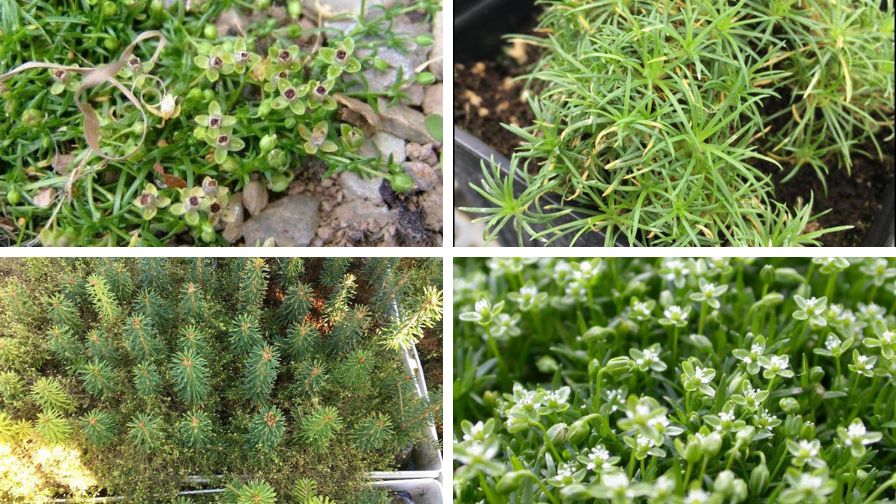
(Clockwise from Top Left) Birdeye pearlwort fruit, branching stems, flowers, and proliferation in containers competing with Christmas tree seedlings | Debalina Saha (Dept. of Horticulture, MSU
Birdeye pearlwort (Sainga procumbens), also known commonly as pearlwort, is a moss-like plant that thrives in environments with consistent levels of moisture. Outside of controlled environments, that includes locations near human habitats, such as:
- Gardens
- Lawns
- Pond edges
- Roadsides
- Seaside cliffs
In controlled production environments, common spots include “propagation benches, flats, and greenhouse floors,” which often have a presence of high humidity and regular watering intervals.
This ability to thrive in such environments makes Birdeye pearlwort a resilient weed of sorts in greenhouse container production, where it can quickly appear and steal space and resources from other plants. In response to this common problem, Assistant Professor Debalina Saha and Graduate Research Assistant Supti Saha Mou of Michigan State University (MSU) have covered the practices of identification and management for the unwanted presence of pearlwort in a recent e-Gro alert.
Identifying Birdeye Pearlwort
Professor Saha and her research assistant highlight the notable features of pearlwort for easier identification:
Root
Birdeye pearlwort is anchored through a taproot, with a primary root and additional branching stems for stabilization and to help it spread to take up more space in its growing area.
Stem
The stems of pearlwort are green and hairless. When growing, they “ascend or, more commonly, grow prostrate along the ground.” Additionally, as the stems grow in this prostrate method, they root at the nodes, enabling a mat-like structure that gives the plant its moss-like appearance.
Leaves
Birdeye pearlwort leaves are “small, about 1 mm wide, hairless, and toothless.” They are absent of stalks but have a tiny, “bristle-like” tip. Leaves are longest near the ground and shorten as they progress up the stem.
Flower
The flowers of pearlwort are very small and “can be difficult to observe without magnification.” Each flower “contains four tiny white petals,” enclosed by green sepals. Additionally, the flowers also have “four stamens with white antlers and a yellowish-green ovary in the center.”
Seed and Propagation Method
Birdeye pearlwort produces a fruit that contains seeds that are released upon blooming, acting as one of its primary propagation methods. Its seeds can “stay viable in the soil for more than five years.”
Common Misidentification with Similar Species
The pair note that Birdeye pearlwort is often confused with other Sagina species, including:
- Alpine pearlwort (Sagina saginoides)
- Snow pearlwort (S. nivalis)
- Stickystem pearlwort (S. maxima ssp. Crassicaulis)
- Western pearlwort (S. decumbens ssp. occidentalis)
Managing Birdeye Pearlwort
Professor Debalina Saha and Graduate Research Assistant Supti Saha Mou cover the control of pearlwort through both chemical and non-chemical means:
Non-Chemical Control of Birdeye Pearlwort
The most effective method of non-chemical control for pearlwort involves growers taking a look at their irrigation practices. This is because, as mentioned, Birdeye pearlwort thrives in overly moist environments. Exploring additional irrigation methods, such as drip irrigation, improving drainage, and cleaning tools and equipment to prevent seed dispersal can be effective at curbing the spread.
Chemical Control of Birdeye Pearlwort
Herbicides are effective at ridding the rise of pearlwort, but should only be done in the event that non-chemical methods are ineffective. Additionally, herbicides effective at getting rid of Birdeye pearlwort infestation are not recommended for use within greenhouses, and failure to follow instructions may cause crop collapse.
For more information regarding organic mulching benefits and limitations, please read the full e-Gro (Electronic Grower Resources Online) alert “Identification and Control of Birdeye Pearlwort (Sagina procumbens) in Greenhouse Container Production.” Additional and current e-Gro alert pieces from Volume 13 (2024) can be found online.

